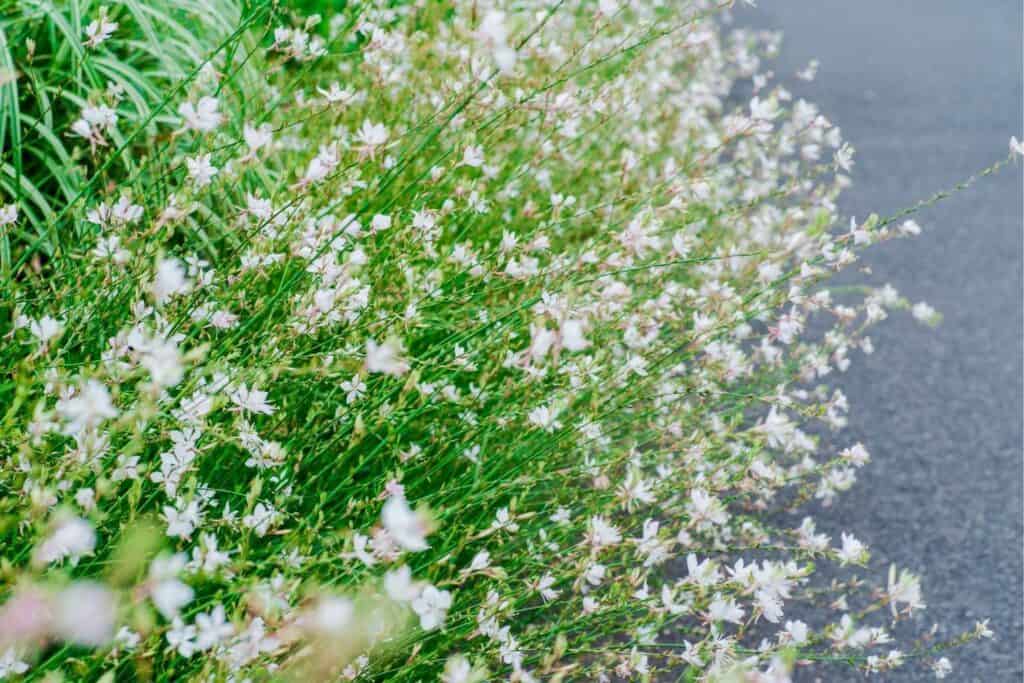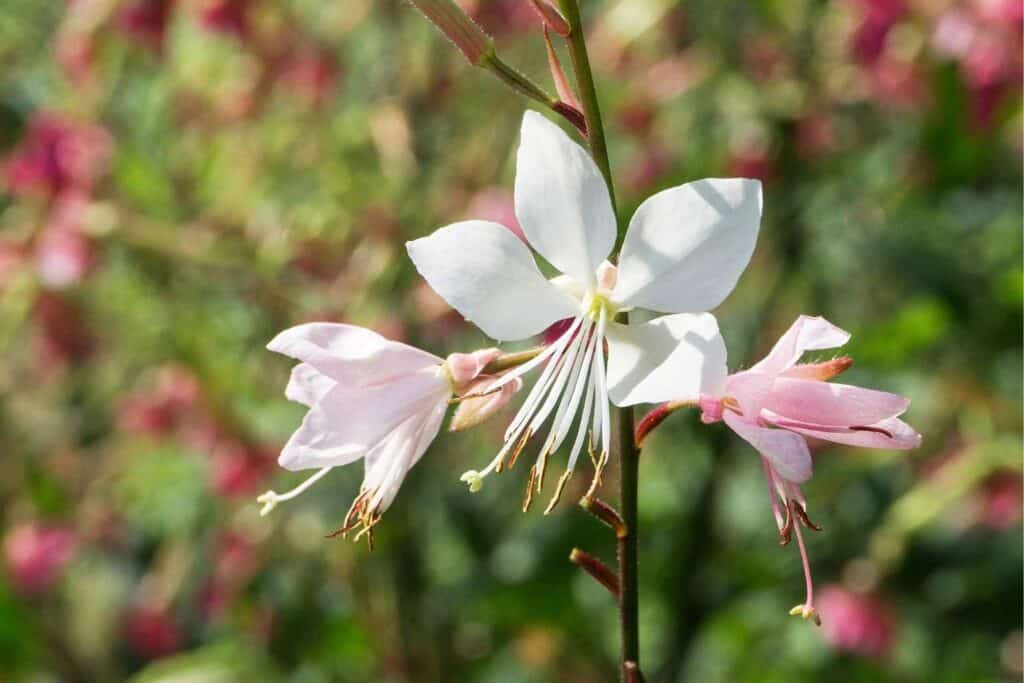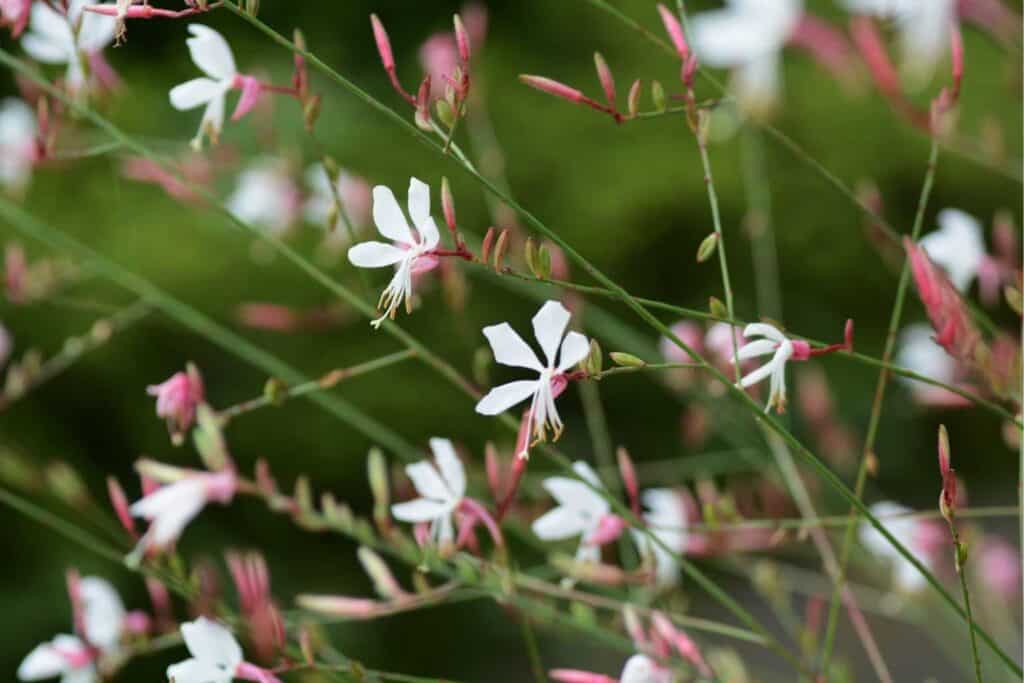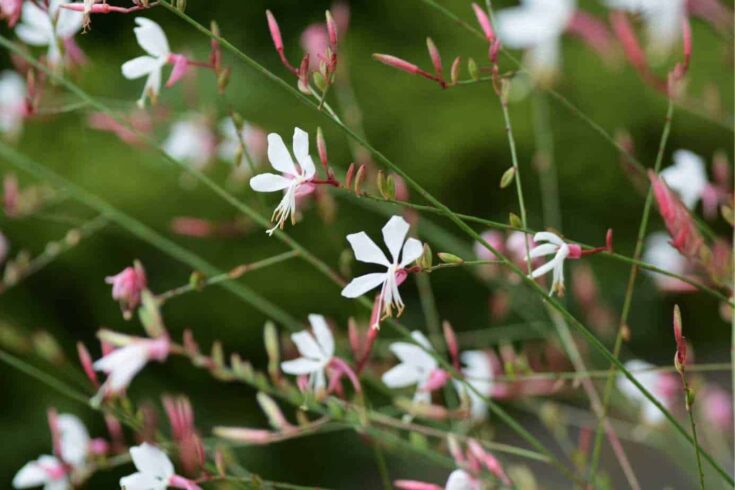Gaura lindheimeri: A Must-Try Flower for Your Garden
Want a delicate plant that sways in the breeze, its flowers like tiny butterflies riding the wind? The plant for you is Gaura lindheimeri, also known as Butterfly Gaura or Whirling Butterflies!

What does the Gaura flower look like?
I was drawn to the gaura plant because it is unlike anything else in my garden. Slender stems with very little leaves and dainty four petaled flowers at the end. The buds are pink and the blooms are white, tinged with pink. Some Gaura cultivars have more pink blossoms.

This plant has a lot of movement in the wind and creates an ethereal look in the garden, and why it is often referred to as whirling butterflies . Gaura is a long bloomer, with flowers lasting from April to November.
Where is Gaura lindheimeri native to?
Gaura lindheimeri is native to Louisiana, Texas and Mexico. However, it can grow in Zones 6-9 as a perennial, and in Zone 5 as an annual.
What are other names for Gaura lindheimeri?
Scientific Name
Each plant species has only one scientific name, but can have many common names. Gaura lindheimeri has traditionally been this plant’s scientific name.
However, its scientific name was actually updated to Oenothera lindheimeri after the plant was recategorized in the early 2000s, but the new scientific name hasn’t really caught on!
Common Names
Common names for the Gaura plant include Butterfly Gaura, White Gaura, Pink Gaura, Wandflower, Whirling Butterflies, Bee Blossom and Lindheimer’s Gaura.
What are the best growing conditions for Gaura?
Gaura likes full sun and well-drained soil. It will appreciate some supplemental summer in the heat of summer. Gaura lindheimeri can be an aggressive grower with the right conditions. It forms colonies and is a good plant if you are looking to cover a large area of your garden.

How do you maintain Gaura lindheimeri?
It is easy to maintain Gaura lindheimeri. The plant will go dormant in the winter. Do the following things to keep it looking great during its growing season:
- Deadhead gaura flowers occasionally to remove old blooms and stems.
- Provide supplemental water during the summer to keep it blooming during drought.
- Cut back mid-summer to encourage another round of fall blooms.
- Keep mulched over winter to protect it from freezing temps.
How do you propagate Gaura?
Gaura lindheimeri can be propagated most easily by seed. Dividing the plant can be tricky due to its long taproot. Some varieties of Gaura can also be rooted from cuttings. I plan to try this with my plant to see if it works! I always use my favorite rooting hormone when making cuttings.
What are good companion plants for Gaura?
Gaura looks great paired with the following plants in the garden:
- Native ornamental grasses such as Pink Muhly.
- Prairie flowers such as Black Eyed Susan and Purple Coneflower.
- Larger leafed or structural plants such as agaves for contrast.
Check out my Top 15 favorite Texas native plants to grow for other pairing options with Gaura.
Where can you buy Gaura lindheimeri?
Your best chances for finding this unique plant at a nursery is to head to a local nursery that specializes in native plants, especially if you live in Texas or Louisiana. I recommend doing a Google search for “native plant nurseries near me”.
If you can’t find the pure native species, you can likely find a cultivar of Gaura lindheimeri. A cultivar will have an extra name in quotation marks after Gaura lindheimeri, such as Gaura lindheimeri “Sparkle White”. Some of the cultivars have more pink blooms than the native Gaura.
Gaura Plant Care Printable
Gaura Lindheimeri: PRINTABLE Plant Care Guide

Oenothera lindheimeri
Native to:Louisiana, Texas, Mexico
Mature Height and Width:2-4 ft. tall / 2-4 ft. wide
Sun Conditions:Full sun
Water Needs:Likes dry to moist well-drained soil. May need supplemental water during drought.
Wildlife Benefits:Good nectar plant for pollinators.
Materials
Instructions
Watering
Prefers dry to moist, well drained soil. Provide supplemental water as needed during drought.
Pruning
Deadhead end of stems occasionally to promote more blooms.
Propagating
Gaura lindheimeri can be propagated by collecting seeds. Some varieties will also root from cuttings. Gaura has long tap root making transplanting difficult.
Notes
Pair with native ornamental grasses, Purple Coneflower and Black Eyed Susan!
Recommended Products
As an Amazon Associate and member of other affiliate programs, I earn from qualifying purchases.

Welcome to Native Backyards! I’m Haeley from San Antonio, Texas, and I want to help you grow more native plants.
I have seen firsthand how the right plants can bring your yard to life with butterflies, bees, and birds. I’ve transformed my yard with Texas natives and I’m excited to share what I’ve learned with you.
Join my newsletter here! – each week I’ll send you helpful tips to make your native plant garden a reality!
Want to learn more about me and my garden? Check out my About page!




Nice site! My name is Fox Cashell and I live in East Texas and last year we had to cut several very tall trees down in our backyard and was very upset about disrupting the canopy ecosystem in doing so and grieved the loss, and as spring came round I looked out at the yard and crummy stumps thinking I need to mow/weedeat and tighten things up, but something said not yet…WAIT, See what native plants come up, so I did and we were rewarded and surprised with MANY native species that had not seen the sun in decades, there were shrubs like elderberry and shrubby boneset, subshrubs like St Anthonys cross and flowers like native vervain/verbena,wild geranium,rain lillys etc.. and the butterflys have innundated my yard. I have maypop vine, coral honysuckle, and many many others that pollinators love and I cant name and have to look up! So I guess I took the challenge and didnt even know there was a challenge but did know there was a MAJOR PROBLEM with pollinators and had already started planting natives around, before the tree business came up, so now the yard has become the “canopy ecosystem”and its been fun seeing and attempting to ID all the early spring natives- mid- spring/summer natives and fall natives each coming up in a show of gratitude for turning on the light so to speak! Natives are the way to go for sure! The lightning bugs,hummingbirds Butterflys,bees and insects of all stripes are everywhere! Thank you for the site and may you be blessed in all you do! It has been hard trying to find out what the different species are and am glad when I find sites like yours to reference and learn! Thank you and have a blessed day.
Thanks so much for sharing your story, Fox! What a wonderful thing to experience in your own yard, and I’m so happy that you are learning along with it. Hopefully your neighbors will take note and want to make changes to their yards as well!